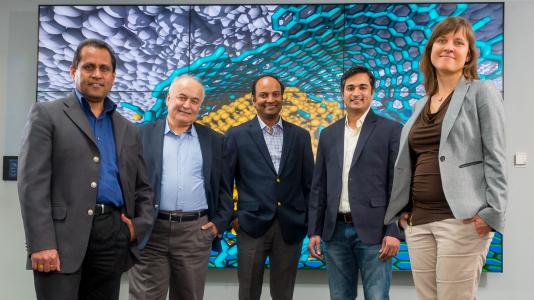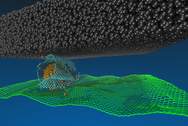
The team combined diamond nanoparticles, small patches of graphene, and a diamond-like carbon (DLC) material to create superlubricity, a highly desirable property in which friction drops to near zero.
As the graphene patches and diamond particles rub against a large DLC surface, the graphene rolls itself around the diamond particle, creating something that looks like a ball bearing on the nanoscopic level. At the atomic level, friction occurs when atoms in materials that slide against each other become “locked in state,” which requires additional energy to overcome. This is because the positioning of atoms causes an entanglement between the materials that prevents easy sliding. By creating the graphene-encapsulated diamond ball bearings, or “scrolls”, the team found a way to translate the nanoscale superlubricity into a macroscale phenomenon. Because the scrolls change their orientation during the sliding process, enough diamond particles and graphene patches prevent the two surfaces from becoming locked in state.
Team members from CNM’s Theory & Modeling Group used large-scale atomistic computations on the Mira supercomputer at the Argonne Leadership Computing Facility (ALCF) to prove that the effect could be seen not merely at the nanoscale but also at the macroscale. This is because a scroll can be manipulated and rotated more easily than a a sheet of graphene or graphite. However, the team was puzzled that while superlubricity was maintained in dry conditions, in a humid environment this was not the case. Because this behavior was counterintuitive, the team again turned to atomistic calculations. The latter showed that scroll formation was inhibited in the presence of a water layer, therefore causing higher friction.
While the field of tribology has long been concerned with ways to reduce friction — and thus the energy demands of different mechanical systems — superlubricity has been treated as a tough proposition. The nanoscroll system results in reduced contact areas and a significantly reduced coefficient of friction, with a potential savings in energy cost that could potentially be applied to everything from engines or turbines to computer hard disks and microelectromechanical systems.
Work carried out at CNM involved design, synthesis and characterization of the system. Atomistic simulations showing the mesoscopic link bridging the nanoscale mechanics and macroscopic experimental observations were carried out utilizing resources at the NERSC and ALCF computing centers. Tribological tests were carried out in Argonne’s Energy Systems Division.
“Macroscale superlubricity enabled by graphene nanoscroll formation,” D. Berman, S. A. Deshmukh, S. Sankaranarayanan, A. Erdemir, and A. Sumant, Science, 348, 1118 (2015)
